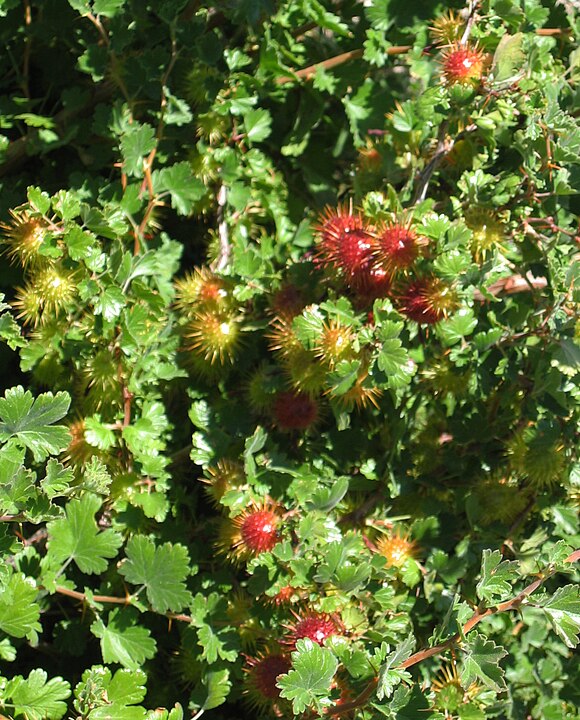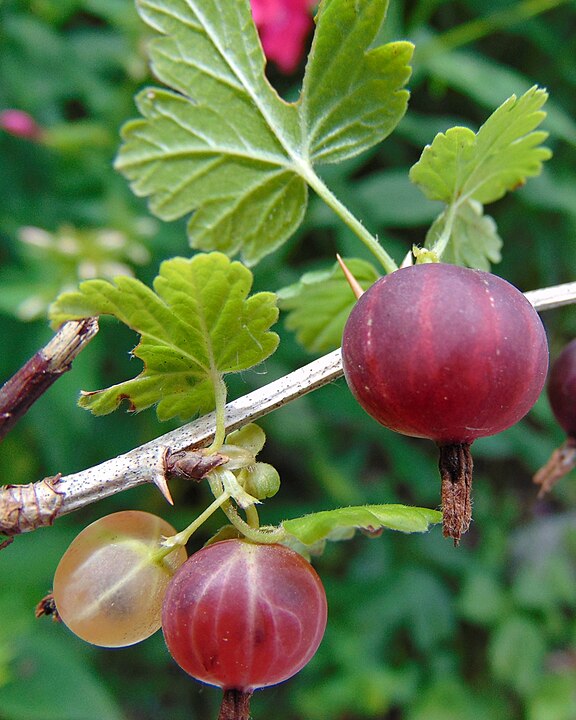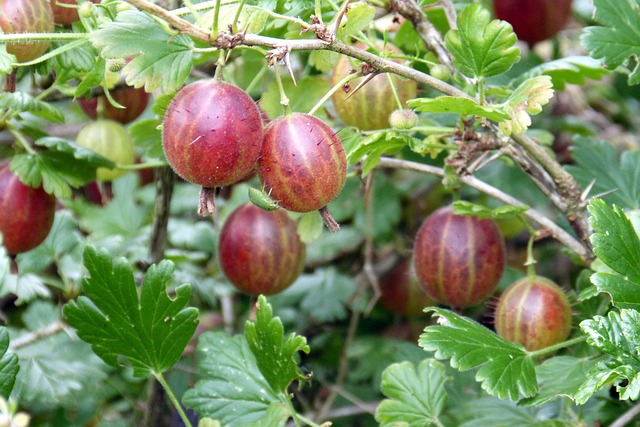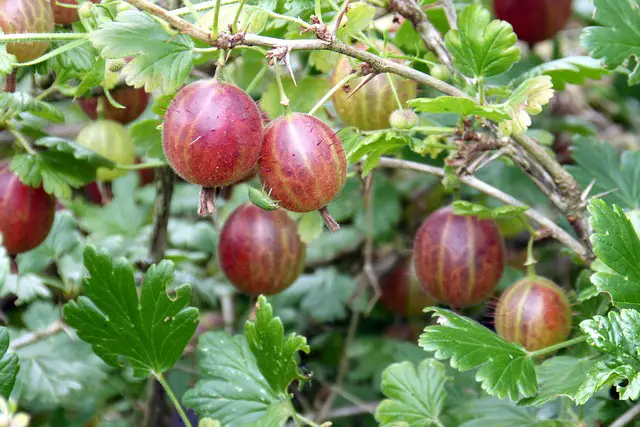Gooseberries are plentiful across the United States. On the West Coast, you’ll often find prickly gooseberry, like the Sierra gooseberry. You’ll also find fresh gooseberries that look like currants, which makes sense because both gooseberries and currants are from the Ribes genus of wild berries.
With so many types of wild gooseberries around, it can be confusing to identify these natural treasures and figure out what’s safe to eat. Let’s break down what we know.
Are Wild Gooseberries Edible?
Yes, wild gooseberries are indeed edible, offering outdoor enthusiasts a unique culinary experience. While there are a few considerations to keep in mind, such as potential allergic reactions and proper identification, gooseberries can be a delightful addition to your wild edible collection.
There are many different types of gooseberries growing wild across the country. You’ll find that their many different varieties are tart and a little bit sweet. You’ll usually see them growing with thorns on their vines and sometimes growing right on the fruit. If your gooseberries don’t have thorns right on the berry, you can snack on them right on the trail after you correctly identify them.
If your gooseberries have big thorns on the fruit, you’ll want to remove those before consuming them. Bring gloves when you go foraging to keep your hands safe. One suggestion is to boil the fruit, gently remove the spines, and strain the fruit’s pulp to make juice or syrup.


The Different Types of Gooseberries
Gooseberries belong to the Grossulariaceae family in the genus Ribes. They come in various species and varieties, including American gooseberries (Ribes hirtellum) and European gooseberries (Ribes uva-crispa).
American gooseberries are native to the United States and were once banned due to concerns about their role in spreading white pine blister rust, a fungal disease harmful to white pine trees. European gooseberries, introduced to North America in the early 1900s, are known for their culinary uses.
While Cape gooseberries (Physalis peruviana) share the same name with American and European gooseberries, they don’t fall under the horticultural classification of true berries.
I’ll give brief mention here to the Chinese Gooseberry (Actinidia chinensis) or kiwi fruit. The kiwi fruit is actually a gooseberry. While it is native to parts of China, it is also cultivated in New Zealand, the United States, Italy, Greece, Iran, Chili, Turkey, France, and Portugal.
Where to Find Gooseberries
Gooseberries thrive in a range of environments, from woodlands to open fields. Look for them in areas with plenty of sunlight, as they prefer full sun exposure. You may also find gooseberry plants near other berry-bearing shrubs like currants. Keep an eye out for them during your outdoor explorations, particularly in areas with rich, well-drained soil.
Gooseberries can be easy to confuse with currants. One way to tell the difference is the way the fruit is growing on the branches. Currants grow in clusters gathered at the end of branches. Gooseberries grow in a line hanging down from the branches, fairly evenly spaced from the center to the end of the branch.

How to Identify Gooseberries
Identifying gooseberries involves noting their distinctive features. These berries typically grow on shrubs that can reach about three to five feet in height. Gooseberry leaves are lobed and often covered in soft, fine hairs. Before you go foraging for gooseberries, study the shape of the leaf. This will make it much easier to correctly identify the wild edibles you’re looking for. You’ll notice that gooseberry leaves tend to be maple-shaped.
One of the defining features of gooseberry plants is their prickly nature. The “spite of the prickles,” as we like to call it, refers to the determination of foragers and nature enthusiasts who brave the thorny stems to harvest these delectable fruits. While the prickles might seem daunting, they are a testament to the plant’s natural defenses and adaptability to various environments. With proper caution and tools like thick gloves, you can navigate through the prickles of the gooseberry bushes and enjoy the rewards of your efforts.
What Time of Year Should I Look for Gooseberries?
The prime time for gooseberry foraging depends on your location and the specific species you’re searching for. In general, early spring is an excellent time to start scouting for young leaves and flower buds. The berries themselves usually ripen in the summer, depending on your location and type of gooseberry. Ripe gooseberries can vary in color, from green to red, yellow, or even dark purple, depending on the variety. When they are fully ripe, they should be easily plucked from the plant with a gentle tug. Sierra Gooseberries or other prickly varieties require gloves to keep yourself safe from the plant’s thorns.
It can be helpful to get a rough idea of when to look for gooseberries in your state. For example, in Nebraska, you can look for the Missouri gooseberry (Ribes missourience), hairy-stem gooseberry (Ribes hirtellum), or northern gooseberry (Ribes oxyacanthoides). These are likely to ripen in Nebraska in the middle of July through August. Another example is Wyoming, where whitestem gooseberry (Ribes inerme) grows heavily at higher elevations in the mountains. They also have Rocky Mountain gooseberry (Ribes montigenum). In Wyoming, it’s best to look for gooseberries in early August and September.

Sierra Gooseberry
In the rugged terrains of the Sierra Nevada mountain range, you might come across the Sierra gooseberry (Ribes roezlii). Known for its distinctive prickly stems and edible fruits, this gooseberry species has adapted to thrive in challenging environments. The prickles on the stems, though formidable, are a natural defense mechanism against herbivores.

Cape Gooseberries
While the Cape Gooseberry (Physalis peruviana) is not actually related to American and European gooseberries, they share the same name. Cape Gooseberries are actually native to South America, but people now cultivate them in the United States and Canada. They now grow wild in the United States, particularly in the north-central and northeast parts of the country.
The Cape gooseberry is also known as the ground cherry or goldenberry. Its small, round fruit is encased in a papery husk. Cape gooseberries have a sweet-tart flavor that can be used in both sweet and savory dishes. Their unique appearance and tropical origin make them a fascinating find for adventurous foragers.
Health Benefits and Culinary Uses
Beyond their delectable flavor, gooseberries also offer a range of health benefits. Packed with antioxidants, vitamins, and fiber, they make a nutritious addition to your diet. Some studies have suggested that gooseberries may lower cholesterol, blood pressure, and blood sugar.
Their unique tartness pairs well with both sweet and savory dishes. From jams, jellies, and pies to gooseberry fool—a traditional British dessert—to incorporating them into salads and even using them as a topping for ice cream, the culinary possibilities are endless.
If you’re seeking the ultimate culinary experience with gooseberries, look no further than the classic gooseberry pie. The tangy-sweet flavor of ripe gooseberries complements the buttery pastry crust, creating a symphony of tastes that’s hard to resist. Experiment with spices, sugars, and even combining gooseberries with other fruits from your foraging adventures for a twist on tradition.
Fungal Disease Concerns: White Pine Blister Rust and the Federal Ban
One of the interesting historical aspects of gooseberries in the United States revolves around their association with the spread of white pine blister rust, a fungal disease that affects white pine trees. Due to concerns about this disease, there was a federal ban on the cultivation of gooseberries in certain areas. This ban aimed to prevent the disease from spreading to valuable timber resources. Fortunately, the ban has been largely lifted, and many gooseberry varieties are now enjoyed by foragers and gardeners alike.
Like many plants, gooseberries are not immune to challenges in their growth. One common issue is powdery mildew, a fungal infection that can affect the leaves and stems of the plants. This can lead to reduced growth and vigor. As foragers, it’s important to understand these challenges and to be mindful of the health of the plants you encounter. When selecting plants for foraging, look for those that appear healthy and vibrant.

Foraging for Wild Gooseberries
The best way to approach foraging for edible gooseberries is with a trusted field guide, a second source you can also check in with, and a good idea of the poisonous berries in your area that you’ll need to avoid.
As you embark on your journey as a wild berry forager, remember that the world of gooseberries is both diverse and full of surprises. From battling fungal diseases to embracing the prickly allure of the Sierra gooseberry, each species offers a story waiting to be discovered. Whether you’re indulging in a classic gooseberry pie or experimenting with exotic Cape gooseberries, the possibilities are endless. Enjoy yourself as you explore the different kinds of gooseberries in your area and discover the variety of flavors growing all around you.
Recent Posts
The only venomous snakes in Washington State are Northern Pacific Rattlesnakes. The Northern Pacific Rattlesnake (Crotalus oreganus oreganus) is a sub-species of the Western Rattlesnake. Anyone...
Skunks are not classified as true hibernators. But they go into a state of torpor when the weather gets cold. Skunks are light sleep hibernators, along with opossums, bears, and raccoons. ...

